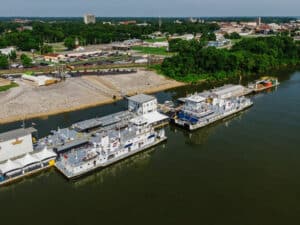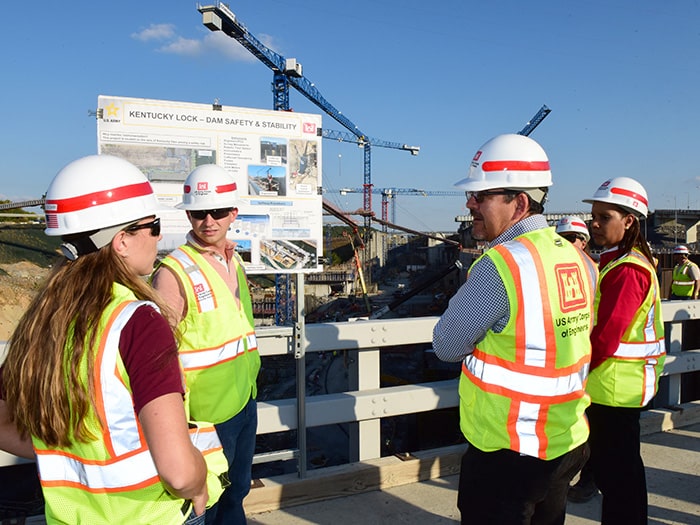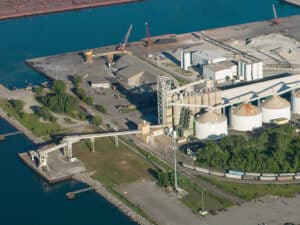
Nashville Engineer District showcases mega construction projects
Written by
Alex Carr (Left) and Dustin Burkett (Second from Left) brief Secretary of the Army for Civil Works Michael L. Connors and Stacey Brown, deputy assistant secretary of the Army for Management and Budget, about dam safety and stability October 12, 2023, during a tour of the Kentucky Lock Addition Project on the Tennessee River in Grand Rivers, Kentucky. (USACE Photo by Lee Roberts).
By Lee Roberts, Public Affairs Specialist, Nashville Engineer District
The Nashville Engineer District recently showcased two of its mega construction projects on the Tennessee River and its hydropower rehabilitation efforts at Barkley Dam on the Cumberland River to the Assistant Secretary of the Army for Civil Works, Michael L. Connors.
Connors and Deputy Assistant Secretary of the Army for Management and Budget Stacey Brown were welcomed to the Chickamauga Lock Replacement Project in Chattanooga, Tenn., the morning of Oct. 12 by Nashville District commander Lt. Col. Robert W. Green.
They received project updates, toured the active lock, and overlooked where Nashville District’s contractor, Shimmick Construction, is constructing a 600-foot by 110-foot navigation lock chamber and has placed more than 200,000 cubic yards or about 80% of the concrete required to complete the project.They also looked at work barges on the upstream side of Chickamauga Dam where the contractor, C.J. Mahan, is placing tremie concrete into drilled shafts on the bottom of the river to anchor the piers for the upstream approach walls.
Elizabeth Burks, Nashville District Integrated Projects Office chief; Resident Engineer Tommy Long, Project Manager Capt. Joseph Cotton, and Lockmaster Cory Richardson briefed Connors and Brown on current navigation operations, the $245 million lock chamber contract, $60.9 million upstream approach wall contract, Joint Risk Register success, and scope of future downstream approach wall and decommissioning contracts.
Connors noted at Chickamauga Lock that visiting projects helps him realize the challenges that Corps of Engineers districts and contractors face with construction projects. He added that interacting with engineers, project managers, and contracting officials builds a greater understanding of the issues that helps him with communicating why projects cost so much, and the benefits of looking for more efficient ways to contract and complete projects.
“The thing you can’t get from briefings and trying to deal with the budget issues and everything else is the complexity of these projects, and the contracting that we have to do and how doing that in different ways can affect the overall financial aspects of the project,” Connors said.
Connors and Adams boarded a Blackhawk helicopter midday from the 101st Airborne Division’s Combat Aviation Brigade at Fort Campbell, Ky, for an aerial tour of the Tennessee Valley Authority dam projects downstream and the navigation locks on the Tennessee River that Nashville District operates and maintains.
That afternoon, they toured the Kentucky Lock Addition Project in Grand Rivers, Kentucky, where the contractor, Tully Group member Thalle construction, is constructing the lock chamber for the new 1,200-foot by 110-foot navigation lock.
Burks and Resident Engineer Jeremiah Manning, Project Manager Bob Winters, Area Manager Mike Looney, and Supervisory Navigation Facility Specialist Caleb Skinner briefed Connors and Adams on current navigation operations, the $380 million lock chamber contract, and scope of future downstream approach walls, lock electrical and mechanical features, lock operations buildings and bridges, and site restoration contracts.
The larger lock is under construction because more than 26 million tons of commercial cargo and goods valued at more than $10 billion pass through Kentucky Lock annually. The average delay for commercial tows through the 600-foot active navigation lock exceeds 10 hours, some of the longest delay times in the system. Tows that are greater than 600-feet have to perform a time-consuming double lockage, which contributes to the lengthy delays. While the old lock can hold nine barges, the new lock will accommodate 15 barges.
Burks explained how the existing lock is too small to meet current and future traffic demands without significant delays, and that the Corps of Engineers has remained resilient through inflationary impacts, labor increases, and supply chain issues to keep the construction project moving forward.
The VIP visitors saw the active lock and walked the full length of the ongoing lock chamber construction site, stopping at different points for specific project updates.
The next morning, they visited the nearby powerhouse at Barkley Dam on the Cumberland River to see ongoing rehabilitation work of the hydropower units, which includes the rotors, turbines, and associated equipment.
HYDROPOWER
Loren McDonald, Nashville District’s Hydropower Support Branch chief, said the Section 212
Program under which the project is being out carried made it possible to enter into agreements with the Southeastern Power Administration, and power preference customers, to reinvest revenues into updating the main powertrain components in the Nashville District’s nine hydropower plants in the Cumberland River Basin.
“Our system on average is 63 years old and up until the last few years have had no major rehabs,” McDonald said. “For Section 212 we have 22 active projects going on across the district right now at $295 million dollars.”
The Hydropower Program supports all of the hydropower plants and 28 hydropower units, and $1.2 billion worth of work is guided by a 20-plus year master plan. Rehabilitations and repairs have been completed on all three units at Center Hill Dam in Lancaster, Tennessee, and unit four at Old Hickory Dam, in Hendersonville, Tennessee.
EDUCATIONAL AND IMPRESSIVE
Connors said his visit to the Nashville District was long overdue. He thanked the teams at all three projects for hosting him and providing information he needs to advocate and make budgetary decisions related to projects across the Corps of Engineers.
“It was highly educational and impressive,” Connors said. “What I loved most was the range of very experienced engineers who have obviously been with us for 20-plus years, and then the new crop of young project managers and engineers doing the work. We see that talent coming up – that’s the best thing to see. The folks that are being trained are going to put us in a good position moving forward decades from now.”

![Tom Frazier aground and listing to starboard on Feb. 11, 2024. [Photo: U.S. Coast Guard]](https://www.marinelog.com/wp-content/uploads/2025/06/Towboataground-300x225.jpg)


